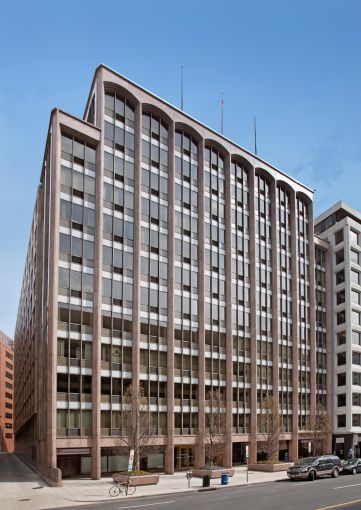Will DC Office to Multifamily Conversions Continue in 2023?
By Keith Loria January 2, 2023 9:55 am
reprints
With more people working from home, and companies looking to downsize space, office vacancy rates have reached historic highs in many parts of the country, leading building owners to pursue creative solutions.
One major trend is converting office space to residential units, and the Washington, D.C. region, which reached more than 20 million square feet of vacant office space this year, was a leader in the trend in 2022.
In fact, D.C. leads the nation in the number of units being added through conversion, according to a report from RentCafe. Nationwide, 11,000 apartments were added from office conversions in 2020 and 2021, out of 28,000 adaptive reuse units overall. In D.C., 1,565 new adaptive reuse units were added to the region’s inventory during that period, more than double the amount of the previous two years, per the report.
And there’s plenty more on the way.
For instance, Altus Realty has plans to convert the historic Denrike Building at 1010 Vermont Avenue NW into an 89-unit multifamily building with 4,081 square feet of ground-floor retail; Foulger-Pratt is converting a 14-story office building at 1425 New York Avenue NW into 255 apartments; and a joint venture between Lincoln Property Co. and Cadillac Fairview have plans to convert two downtown office buildings to apartments at 1125 15th Street NW and 1313 L Street NW.
Overall, there are 13 office buildings in the region that are actively planning a conversion or have started construction, according to Michael Hartnett, mid-Atlantic research director for JLL (JLL).
“When the 13 office buildings slated for conversion convert, 2.8 million square feet of space will be removed from the office inventory,” he said. “If we were to remove that supply from the inventory today, then vacancy rate would drop by 11 percent. The conversions will add hundreds of new residential units, including affordable units, primarily in the CBD and East End and will create a more varied mix of uses in what is today a primarily business district.”
Additionally, there are many more rumored conversions, including hotels.
Lou Christopher, vice chairman for CBRE (CBRE), noted there is likely more talk of residential conversion than actual projects right now.
“Much of Washington D.C.’s office stock does not lend itself well to conversion due to physical limitations of the buildings,” he said, citing ceiling height, limited window line, floor plate size, and column spacing due to the District’s height restrictions. “It will also be more challenging to make the numbers work in an environment of high interest rates and high cost of construction.”
So, while conversions may be a tool utilized to combat the market’s vacancy problem, he warns that they are not the silver bullet.
Ben Plaisted, vice chairman and co-regional manager for Savills’ Washington, D.C. office, noted this trend is not ideal for every building and due to the geometry of the buildings, residential just does not work in a lot of the current vacant office product.
“Due to our height restrictions, most D.C. office buildings have large deep floor plates which do not transition well into multifamily units,” he said. “If you look closely at the buildings that are being redeveloped into residential, they have a narrow floor plate with a shallow depth to the core, and they are on the corner of a block to maximize windows.”
Also, with rising interest rates and the capital markets tightening, Plaisted believes conversion to multifamily is becoming more difficult to pull off in this market.
However, where obsolete buildings can be converted, Christopher believes this could be a boon for the local economy to reposition those buildings to a new highest and best use, and to generate more foot traffic and activity throughout the city.
“Our research across the nation is showing areas that have the right mix of ‘resi-mercial’—residential and combination of office and retail perform the best,” he said. “We’re seeing this trend take hold even in micro-neighborhoods as opposed to whole submarkets.”
For example, CBRE’s D.C. office building at 1900 N Street has performed very well, with workers enjoying a great mix of residential and commercial amenity retailers in addition to proximate outdoor space. However, if you go a few blocks south to K Street, it’s a different story, with much less foot traffic, Christopher said.
Despite the challenges, Matthew Pestronk, president and co-founder of Post Brothers, noted residential-to-office conversions will continue to proliferate throughout the region in 2023, some with a mixed-income component.
“More housing supply at any price point takes pressure off of the least expensive housing stock, which is existing affordable and non-regulated workforce housing,” he said. “In locations where it is very profitable to build market rate housing because rents are high, but there is political pressure to add IZ units, developers should act, as it is better to work in concert with the government rather than not being part of the process of deciding how affordable housing policy is implemented.”
Housing production is a stated goal for D.C. Mayor Muriel Bowser, and Pestronk believes the development community should look to partner with the local government and leverage this policy.
“Things such as a tax abatement for new construction or raising the height limit are not off limits, and the development community needs to work with elected officials to understand that providing affordable housing requires incentives from the government,” he said.
Hartnett expects more conversions to be announced next year as building owners evaluate opportunities in the current market.
“This trend is not unique to D.C., we’re seeing it in markets across the country,” he said.
Keith Loria can be reached at Kloria@commercialobserver.com.\


